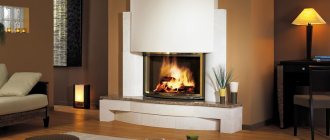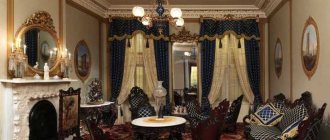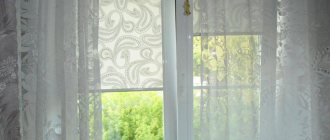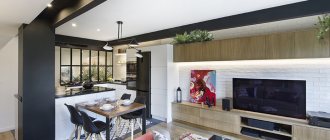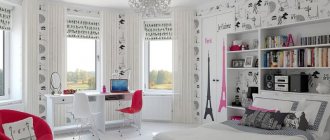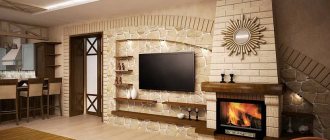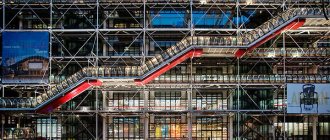How Gothic appeared
The date of birth of Gothic architecture is precisely known. Abbot Sugeria started rebuilding the dilapidated church at the French Abbey of Saint-Denis. Upon completion of the reconstruction, in 1144, a temple appeared before the world, built in a hitherto unknown style, later called Gothic.
The abbot revealed the symbolism of the unusual appearance of the church. According to his idea, the temple is a ship that carries the flock to the mountain heights. The analogy lay on the surface - the vaults resembled sails that caught the wind, and the high columns resembled ship masts. The nave (the space highlighted by columns) is translated from Latin as “ship”.
The first Gothic church was in keeping with the spirit of the times, it was at the same time significant, sublime and impressive. Success caused the spread and further development of Gothic architecture, first in France, and then in Germany, Italy, Britain and other countries.
Interior of Exeter Cathedral Source farm2.static.flickr.com
In its approach to construction, Gothic architecture was fundamentally different from the previous, Romanesque style. Architects discovered a new way of influencing the load on a building, in which the weight and pressure of the masonry were not distributed along the entire perimeter, as before, but were concentrated at certain points. At the same time, the load on other parts of the structure was minimal.
The discovery made it possible to replace the usual cylindrical vault with a new, rib vault, which received its name from the characteristic protruding ribs - ribs that carry the load in the Gothic frame cross vault. The revolutionary frame system opened up impressive possibilities for the construction of the highest and at the same time mystical-airy temples, some of which exceeded the height of the Cheops pyramid.
Structure of the frame system Source cf.ppt-online.org
See also: Catalog of companies that specialize in the installation of fireplaces and stoves
Style development
The canons of Gothic architecture differ somewhat from country to country. In general, European Gothic is usually divided into three types, according to the following intervals:
- Early (lancet). Between 1140 and 1250, the transition to the Gothic style, exemplified not so long ago by Notre Dame Cathedral, was completed. A characteristic feature of the buildings is the combination of powerful walls, a majestic portal above the entrance and high arches. This is how mainly churches and cathedrals are built, and a little later castles.
Notre Dame de Paris, Notre Dame Cathedral Source www.ediscover.ru
- Tall (mature). The period lasted for two centuries. From 1194 to 1400, early Gothic improved, the frame structure became more complex, and the number of stained glass windows and sculptural groups increased. The Gothic style is gaining recognition as a trend in European urban architecture; its merits can be judged, for example, by the cathedral in Reims.
- Late (flaming). Covers the period from approximately 1350 to 1550. Much attention is paid to decorative details, the style becomes more refined and ornate (hence the name). A new development was achieved in the form of sculptural compositions on religious and secular themes. Late Gothic buildings include the Milan Cathedral.
Milan Cathedral Source wikimedia.org
Gothic hairstyles and makeup
The classic goth hairstyle is straight black hair. It's a good idea to give them a slightly dirty look. For a romantic look, curls and bouffant hairstyles are acceptable. Many goth girls prefer to dye their hair a deep red or ash color.
Gothic makeup is a thick layer of white makeup on the face, a complete absence of blush, black eyeliner, pencil or eye shadow, dark or blood-red matte lipstick. Nails are painted with black varnish. Top class, if the manicure and makeup are done a little carelessly.
Main features of Gothic architecture
The medieval cathedral was the center of city life, and was built to accommodate the entire city population. Preachers spoke on the square in front of the cathedral, traveling artists staged performances, and professors and students held discussions. Gothic architecture owes its external charm and performance qualities to the following characteristic features:
- The Gothic style is the characteristic, skyward appearance of all parts of the structure, including spiers, elongated stained glass windows, and narrow turrets.
- Frame construction system. Thanks to its appearance, buildings began to grow higher, and the thickness of the load-bearing walls became smaller.
Buttresses and flying buttresses Source i.pinimg.com
- Pointed arches. They coped well with the load of the upper arch, redistributing it to the lower structures. Thanks to the arrow-shaped arches, it became possible to do without many internal walls, which was impossible in the Romanesque style.
- Additional designs. Arches in the form of arcs and crosses, as well as hanging external semi-arches that can transfer the load outside the building.
- Various decor of the Gothic facade: archivolt (frames of arched spans), wimperg (pointed gable above a window opening or portal), “big rose” (central window of the cathedral), facade decorated with carvings.
Stained glass in a modern interior Source lunev-design.ru
Briefly about styles: Gothic
Gothic is a period in the development of medieval art in Western, Central and partly Eastern Europe.
The word comes from Italian. gotico - unusual, barbaric - (Goten - barbarians; this style has nothing to do with the historical Goths), and was first used as an expletive. For the first time, the concept in the modern sense was used by Giorgio Vasari in order to separate the Renaissance from the Middle Ages.
Origin of the term
However, there was nothing barbaric in this style: on the contrary, it is distinguished by great grace, harmony and observance of logical laws. A more correct name would be “lancet”, because. The pointed form of the arc is an essential feature of Gothic art. And, indeed, in France, the birthplace of this style, the French gave it a completely appropriate name - “ogive style” (from ogive - arrow).
Three main periods: - Early Gothic XII-XIII centuries. — High Gothic — 1300-1420. (conditionally) - Late Gothic - XV century (1420-1500) often called “Flaming”
Architecture
The Gothic style mainly manifested itself in the architecture of temples, cathedrals, churches, and monasteries. It developed on the basis of Romanesque, or more precisely, Burgundian architecture. In contrast to the Romanesque style, with its round arches, massive walls and small windows, the Gothic style is characterized by pointed arches, narrow and tall towers and columns, a richly decorated facade with carved details (vimpergi, tympanums, archivolts) and multi-colored stained glass lancet windows . All style elements emphasize verticality.
art
Sculpture played a huge role in creating the image of the Gothic cathedral. In France, she designed mainly its external walls. Tens of thousands of sculptures, from plinth to pinnacles, populate the mature Gothic cathedral.
Round monumental sculpture is actively developing in Gothic. But at the same time, Gothic sculpture is an integral part of the cathedral ensemble; it is part of the architectural form, since, together with architectural elements, it expresses the upward movement of the building, its tectonic meaning. And, creating an impulsive play of light and shadow, it, in turn, enlivens, spiritualizes the architectural masses and promotes their interaction with the air environment.
Painting . One of the main directions of Gothic painting was stained glass, which gradually replaced fresco painting. The technique of stained glass remained the same as in the previous era, but the color palette became much richer and more colorful, and the subjects were more complex - along with images of religious subjects, stained glass windows on everyday themes appeared. In addition, not only colored glass, but also colorless glass began to be used in stained glass.
The Gothic period saw the heyday of book miniatures. With the advent of secular literature (chivalrous novels, etc.), the range of illustrated manuscripts expanded, and richly illustrated books of hours and psalms were also created for home use. Artists began to strive for a more authentic and detailed reproduction of nature. Prominent representatives of Gothic book miniatures are the Limburg brothers, court miniaturists of the Duke of Berry, who created the famous “The Magnificent Book of Hours of the Duke of Berry” (circa 1411-1416).
Ornament
Fashion
Interior
Dressoir is a china cabinet, a piece of late Gothic furniture. Often covered with painting.
The furniture of the Gothic era is simple and heavy in the truest sense of the word. For example, for the first time, clothes and household items are beginning to be stored in closets (in antiquity, only chests were used for these purposes). Thus, by the end of the Middle Ages, prototypes of basic modern pieces of furniture appeared: a wardrobe, a bed, an armchair. One of the most common methods of making furniture was frame-panel knitting. The materials used in the north and west of Europe were mainly local wood species - oak, walnut, and in the south (Tyrol) and east - spruce and pine, as well as larch, European cedar, juniper.
What to see?
Main features of the interior
The combination of architectural innovations made it possible to significantly expand the internal space, which also did not go unnoticed. Thanks to the high pointed arch, reminiscent of a tree with branching branches, the interior of the Gothic building seems weightless and mysterious, despite the fact that the main building material was stone.
A characteristic feature of the Gothic interior is the skillful use of direct and diffused light. The huge space of the cathedral needed high-quality lighting. The required amount of light was provided by large lancet windows decorated with stained glass, ornaments, and turrets.
Windows made of colored glass played an important decorative role, showing parishioners colorful illustrations of biblical and secular subjects. The vaulted ceilings also contributed; their device made it possible to diffuse the light so that there were no shadows.
Knight's Hall Source i2.wp.com
Gothic is a distinctive style that has influenced all aspects of people's lives. The interiors of castles and town houses are moderately modest and, to the taste of a modern person, romantic. They are characterized by the following design techniques:
- Wooden panels were used to cover the stone walls, which were decorated with bright paintings, wood engravings and carpets. Windows in medieval houses were glazed, but no one had ever heard of curtains.
- The flooring was boards, stone, and later tiles. In the living area, the floor was covered with carpets.
Modern interpretation Source i.pinimg.com
- The traditional medieval ceiling had a beam structure with open rafters, while false ceilings were common. They were lined with boards or slats, and often decorated with paintings.
- A luxurious, richly decorated fireplace is a sign of French and English interiors. In Germany and other northern countries, from the mid-15th century they began to be replaced by tiled stoves.
Recreation area Source vseznayko.com
- The furniture, hewn with an ax from solid wood, is characterized by heavy proportions. In the 15th century, after the advent of the technology of making sawn boards, almost all modern types of furniture appeared. By the middle of the Middle Ages, furniture was richly decorated with carvings, gilding, and painting.
- The set of Gothic furniture included carved cabinets, tables and chairs, armchairs and beds with a canopy that protected from drafts walking through the spacious room.
- A familiar and extremely useful interior detail was a chest in which things were stored and on which people sat.
Late Gothic furniture
Facade
The main characteristics of the Gothic style façade are:
- High walls, sometimes with imitation of columns or half-columns;
- Elongated lancet windows of large sizes. They can be either single or grouped, with a larger one in the center. As a rule, they have a massive frame and stained glass patterns, sometimes even on plain glass;
- “Rose” is a round window divided by a figured frame into elements symmetrical relative to the center, reminiscent of flower petals or parts of a star;
- Portal. It is the main entrance to the building, decorated in a special way. Designed to visually enlarge the doorway, which is achieved by repeating it many times. May contain cornices, platbands or pilasters, complemented by bas-reliefs and sculptures;
- Triangular gables (vimpergi) are protruding parts of the facade of a building, bounded on the sides by two roof slopes and a cornice at the base. Used to decorate balconies and entrances;
- Massive forged doors. To match the Gothic style, their openings should have an elongated, pointed shape with a deep arch, decorated with sculptural ornaments.
- Arched structures, including semi-arches. Designed to give the structure visual airiness and weightlessness.
Gothic façade
"Portal" in Gothic style
"Rose" in Gothic style
Neo-Gothic and modernity
Interest in Gothic architecture was revived at the end of the 18th century and was marked by the emergence of a new direction - neo-Gothic, characteristic, for example, of the campuses of reputable educational institutions. Secular buildings also appeared, for example, the city council building in Munich or Berlin.
The Gothic interior design of the houses of noble Europeans took shape towards the end of the 19th century, when the fashion for lush and at the same time gloomy decor in the style of a knight's castle appeared. Today it can hardly be called universal: it is of little use for decorating a standard living room, but it looks good in a spacious room in a country estate. To embody the modern Gothic style, one cannot do without a certain stylization and the following elements:
- Spacious room with high ceilings and large windows.
Gothic bedroom Source i.pinimg.com
- Use of natural materials: wood, stone, metal.
- Characteristic palette: blue-black, golden, brown, violet, emerald, dark blue, rich red and silver.
Interior with fireplace Source roomester.ru
- To prevent the interior from becoming too gloomy, the palette is diluted with light colors, or, as an option, mixed with other styles.
- Furniture with medieval charm: heavy, carved, with forged parts, decorated with gilding and painting. Upholstery made of luxurious fabrics, velvet or brocade in dark shades will look harmonious.
Light Gothic Source kstudiosdesign.files.wordpress.com
- Accessories. Details are an important part of the medieval setting. Don’t forget about stained glass windows, themed tapestries, and bronze candlesticks. The worn leather chest looks like an atmospheric detail.
- Lighting. The finishing touch will be a forged chandelier with lamps in the shape of a candle in the wind, which will be complemented by suitable lamps and sconces.
Kitchen-dining room Source roomester.ru
Modern Gothic in cottage construction in Russia
If there was no trace of Gothic in Rus', then significant interest has shown in the place of pseudo-Gothic in the modern world of Russia. Houses and cottages with vertically oriented turrets, with pointed gables and decorative pointed arches are becoming increasingly popular.
The roofs of the cottages are steep and multi-pitched
Forged spiers catch your eye. The roof is either composite ceramic or bituminous shingles, always dark in color.
Instead of medieval lancet windows, designs included a narrow type of tall rectangular window, often complemented by stained glass.
The Gothic style has not sunk into oblivion, but still remains in books, cities, minds and hearts of many people, as an amazingly deep and beautiful word in the history and era of architecture.
